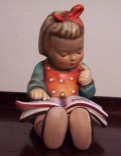Ideas for using
STAR BLANKET
in the classroom
When Laura goes to bed at night, she asks her father for the story of the Star Blanket. It was given to him when he was a child and is deep dark blue with forty-one white stars, each one named after a member of the family.
Do your students have favorite bedtime stories? Are they family stories, folk tales such as the Three Bears that their grown-ups have memorized, or books that are read to them? Make a class list of favorite stories. Let students share them with each other. You can graph them to show how many are family, folk tales or books.
Do your students have (or did they have when they were younger) a favorite blanket, animal or doll that they sleep with each night? Pat Brisson had a favorite satin blanket that was loved to pieces. She also had a brown and gold teddy bear, a present to her on her first Christmas, which she still has! You can see a picture of it here.
Bring in samples of fabric: satin, corduroy, fleece, velvet, denim, wool, cotton knit are some examples. What words can your students use to describe them? (smooth, rough, soft, bumpy, prickly, etc.) Have your students discuss and vote for the one they think would make the best bedtime blanket.
Do your students understand how someone becomes an aunt, uncle, grandparent or cousin? There were 41 stars on the Star Blanket because Tommy had 41 people in his family on his mother's side. How many stars would your students have on their Star Blankets? Let them draw their Star Blankets and list the names on each star.
Your class can make a Class Star Blanket bulletin board with a star for each student on a deep dark blue background. Or you might hang stars from the ceiling, perhaps with the name of a child (or a child's relative) on one side and a few words about what makes them special on the other.
The setting of a story is where the story takes place. STAR BLANKET has many different settings. Look through the illustrations with your students and see how many different settings they can find in this book.
Pat's father called her the caboose because she was the last child born in her family and the caboose is the last car on a train. Do your students have special names that their parents or family members use? Ask if they are willing to share. You can make a game of this by having the children whisper the name to you so you can make a list, then have the students guess which nickname goes to which child.
The caboose is the last car on the train and serves as the conductor's office and living quarters for the crew. Do your students know any other types of cars on a train? Do they know where they can go to find out more? Ask your librarian to help with a simple research project on trains and let each student draw a car for a train around your classroom.
Uncle Dave gave Tommy a silver dollar and told him not to forget a single name on the star blanket. Have your students ever seen a silver dollar? Try to find some Sacajaweja and Susan B. Anthony dollars. If you're able to find some Eisenhower and Liberty dollars, point out that coins have gotten smaller and discuss possible reasons for this change. Let your students do rubbings of the coins. Find out who the people are on the coins and why they're honored in this way. Do your students know what the people on other US coins are? You could do a class research project and present your findings to another class with oral reports.
Never heard of Hopalong Cassidy? Go to www.hopalong.com to see him with his horse Topper, hear the very perky theme music from the show and to hear Hoppy's Creed for American Boys and Girls (go to The Legend from the first screen.)
